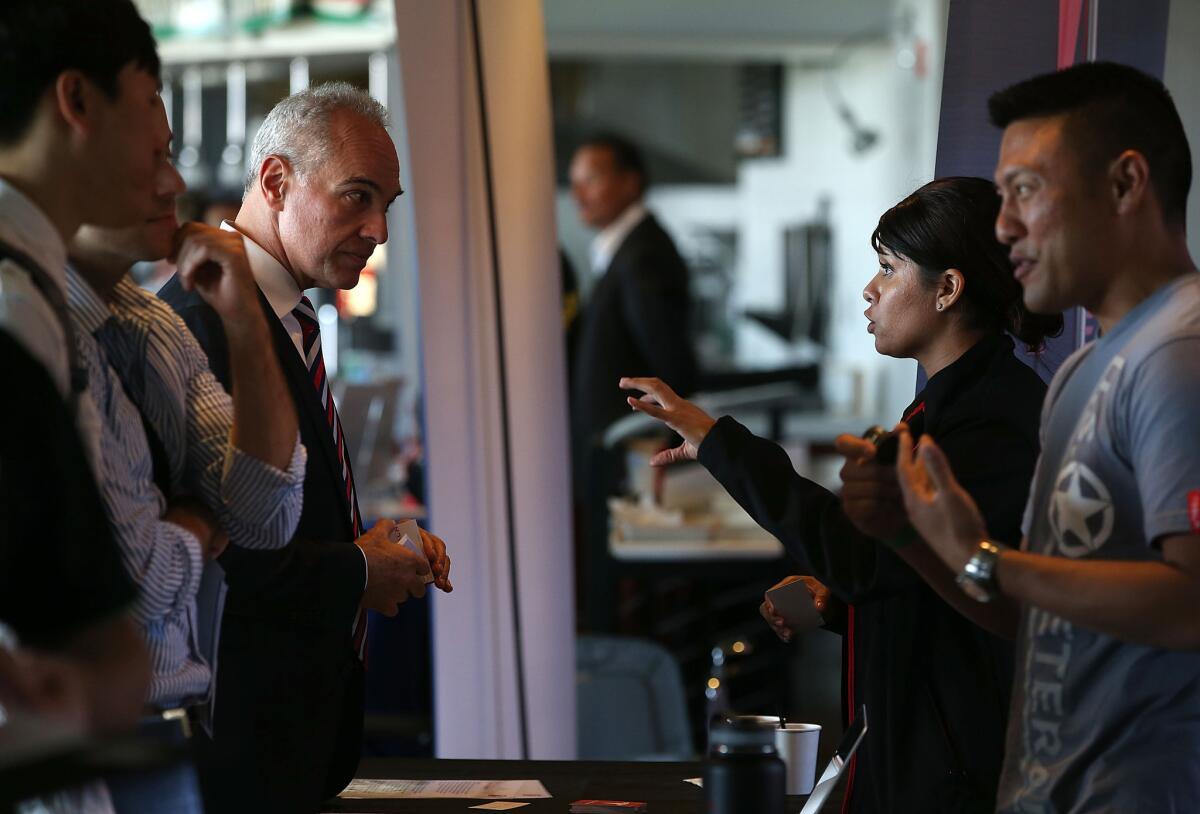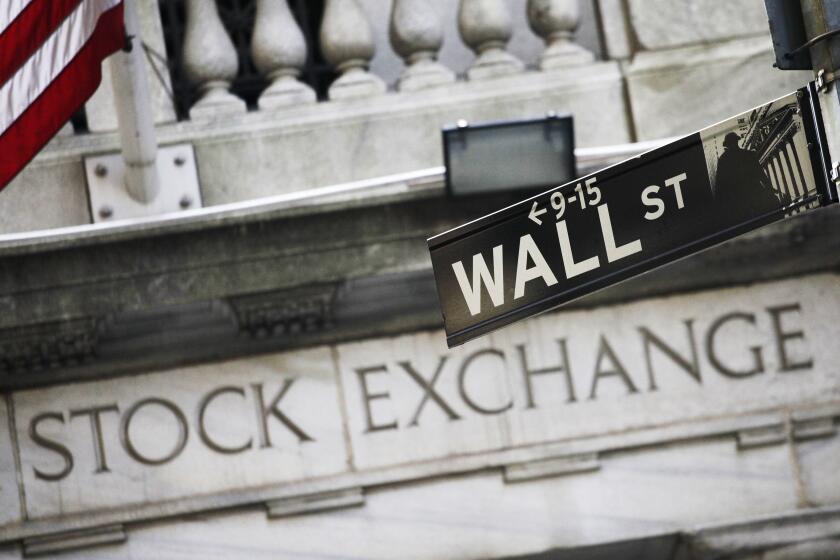Five takeaways from the strong U.S. jobs report

Job seekers meet with recruiters during the Hiring Our Heroes Job Fair at AT&T Park in San Francisco in August.
- Share via
Reporting from Washington — Despite a slowing global economy, the U.S. jobs market showed surprising strength last month.
The nation added 292,000 net new jobs, the Labor Department said Friday, exceeding analyst expectations. The unemployment rate held steady at 5%, the lowest level since early 2008.
Here are five key takeaways.
Back-to-back robust years of job growth
With December’s job growth and an additional 50,000 net new positions added to the previous two months, the U.S. labor market capped off a second-straight stellar year.
The economy added 2.65 million jobs in 2015. And while that was down from 3.1 million jobs the previous year, it was still just the second time since the Internet boom of the late 1990s that job growth topped 2.6 million.
Combined, the previous two years were the best back-to-back performances by the U.S. labor market since 1998-99.
“Given the external weakness that the global economy has evidenced over the course of 2015 … that we’ve had two back-to-back years of decade-high gains I think is very encouraging,” said Patrick O’Keefe, economic research director at accounting and consulting firm CohnReznick.
He’s not worried that job growth slowed somewhat in 2015 from the previous year. The pace continued to be strong, and the strong number reflected a mature economic expansion, O’Keefe said.
More people are jumping into the labor force
The unemployment rate held steady at 5% in December, the third-straight month at that level.
Join the conversation on Facebook >>
Earlier in the recovery from the Great Recession, the unemployment rate sometimes went down — not because more people went back to work, but because more people dropped out of the labor force.
But that hasn’t been the case recently.
The civilian labor force expanded by about 466,000 last month, according to the jobs report. That helped nudge up the share of adults in the workforce to 62.6%.
The so-called participation rate remains near its lowest levels since the late 1970s. That is partially because the older baby boomers are starting to retire. But the upward movement in the rate means that people who had dropped out of the workforce are jumping back in.
Overall, the labor force increased by 1.7 million people in 2015. That was the biggest expansion since 2006, before the Great Recession hit.
Wage growth is lagging
The biggest disappointment in Friday’s report was a slight reversal of wage growth.
After two strong monthly gains, average hourly earnings declined by 1 cent to $25.24 in December.
With robust job growth, pressure should be building on employers to boost wages to keep and lure workers.
That appeared to be happening when average hourly earnings rose 5 cents in November and 8 cents in October.
December’s slip could be an anomaly. Other data on worker compensation, which also includes healthcare and other benefits, have been moving higher.
NEWSLETTER: Get the day’s top headlines from Times Editor Davan Maharaj >>
Still, 2015 was the best year for wage gains since the Great Recession. Average hourly earnings increased 2.5%, well above the low rate of inflation.
Earnings rose 1.8% in 2014.
“In a normal year with normal inflation, 2.5% wage growth would be nothing to crow about,” said Harry Holzer, a professor of public policy at Georgetown University and coauthor of the 2011 book “Where Are All the Good Jobs Going?”
“Last year, inflation was close to zero because of falling oil prices,” he said, so “at least there’s some real wage growth.”
Manufacturing and mining still struggling
Much of the U.S. economy is insulated from the global economy because domestic consumers drive most of the nation’s growth.
But two sectors are vulnerable.
Much of the mining industry involves extracting oil and other energy products. Early in the recovery, mining was a bright spot as U.S. energy production increased.
But with oil prices falling sharply since last year, mining companies have been shedding jobs.
The sector reduced its payrolls by 8,000 net jobs in December, though that was an improvement over the 11,000 positions lost the previous month.
Overall, the mining industry lost 129,000 net jobs last year after adding 41,000 in 2014.
“One of the greatest strengths of the U.S. economy in recent years had been the energy sector, and all of a sudden, that story has been put on hold,” said Mark Hamrick, Washington bureau chief of financial information website Bankrate.com.
The increasing dichotomy between the state of the U.S. economy and that of many other nations, including China, has led the value of the dollar to rise. That makes U.S. products more expensive abroad and has caused exports to tumble.
When that happens, manufacturers take a hit.
The sector added just 30,000 net new jobs last year, a far cry from the 215,000 gain in payrolls the previous year.
That made last year the worst for manufacturing job growth since 2009.
But in a small positive, the industry added 8,000 net new jobs in December. That was up from 2,000 the previous month and the best performance since July.
Potential complications for future interest rate hikes
The Federal Reserve raised its benchmark short-term interest rate 0.25 percentage point in December, satisfied that the labor market had improved enough to warrant ending the near-zero rate policy in place since late 2008.
The December jobs report validates that assessment as the Fed considers how often to raise the rate this year.
But for some Fed policymakers, the decision to increase the rate was a close call, according to minutes of their December meeting released this week. Those officials were concerned that inflation remained well below the central bank’s 2% annual target.
The lack of wage growth in December means there’s less upward pressure on inflation and could cause Fed policymakers to wait on the next rate hike.
In their economic projections, a majority of the Fed’s 17 policymakers anticipated four additional 0.25 percentage-point increases this year.
John Canally, chief economic strategist at LPL Financial, a brokerage and investment advisory firm, said continued sluggish wage growth could lead the Fed to increase the rate just three times this year.
Follow @JimPuzzanghera on Twitter
MORE BUSINESS NEWS
U.S. stocks end their worst week since 2011
Macy’s woes could signal trouble for retailers
Gap stock plunges after holiday sales fall, including at Old Navy
More to Read
Inside the business of entertainment
The Wide Shot brings you news, analysis and insights on everything from streaming wars to production — and what it all means for the future.
You may occasionally receive promotional content from the Los Angeles Times.











